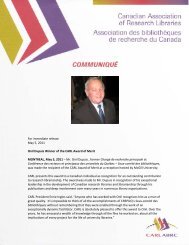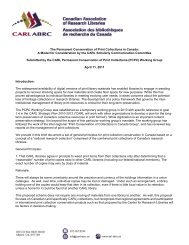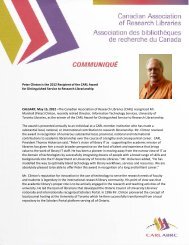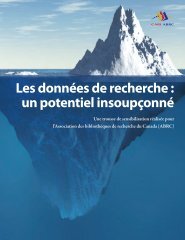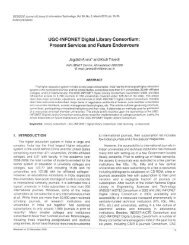PDF - CARL - ABRC
PDF - CARL - ABRC
PDF - CARL - ABRC
Create successful ePaper yourself
Turn your PDF publications into a flip-book with our unique Google optimized e-Paper software.
directors who preferred a provincial repository indicated that though<br />
ideally a national approach would be the best, a provincial initiative<br />
was more realistic.<br />
Monographs and Documents<br />
Eleven of 18 directors (1VL, 3L, 3M, 4S) felt that the best goal for<br />
OCUL with respect to collaborative print storage was one which would<br />
see storage of unique Ontario collections, including monographs,<br />
serial collections, and Ontario government documents. The goal<br />
would be to develop a storage program that contributed to an Ontario<br />
research collection while at the same time addressing ongoing needs<br />
to re-allocate space in local facilities.<br />
Content and Service Issues<br />
Fourteen directors (3VL, 4 L, 3M, 4S) indicated that the service<br />
model developed for any collaborative print storage initiative would<br />
play a key role in the success of that initiative. The majority of<br />
respondents who raised this issue felt that the development of a “light”<br />
storage solution would be preferable; items would be available through<br />
digital delivery to desktop, interlibrary loan of physical items, and onsite<br />
access. Digital delivery would allow a reasonable turnaround time<br />
for requested information, as well as provide geographic flexibility for<br />
any central facility, for any type of distributed solution.<br />
Fifteen directors (3VL, 5L, 2M, 5S) felt that an analysis of content of<br />
materials being considered for removal to storage was necessary.<br />
Specifically, the concern over content was in not knowing how closely<br />
the digital versions matched or duplicated the print version being<br />
discarded or sent to storage. Another content verification issue that<br />
was discussed several times was the need to establish a process to<br />
determine, with some degree of reliability, the true print and<br />
electronic holdings of each institution. The answers to these content<br />
concerns may affect decisions about whether materials should go to<br />
storage or be discarded.<br />
A Central or Distributed Model<br />
Nine directors (2VL, 2L, 1M 4S) felt that a central model would be<br />
the most appropriate for any type of OCUL collaborative print storage<br />
initiative. The majority preferred a central facility attached to and<br />
managed by a specific OCUL institution, with the rest of OCUL<br />
contributing on some sort of cost-share metric. The central management<br />
model presumes a single facility to which each OCUL institution<br />
would send items. The management of such a facility could be<br />
contracted out to a third party or be attached to one specific OCUL<br />
institution. Regardless of affiliation, there would be a staff presence to<br />
deal with additions and deletions of material and requests for access.<br />
The advantages of the central model include maximizing and focusing<br />
staff costs to deal with repository management and service, and<br />
increased probability of long term sustainability. The disadvantages of a<br />
central model are that it would demand significant and immediate upfront<br />
costs to build and staff a facility. It would also require extensive<br />
initial planning to determine the logistics of what materials came into<br />
the repository and how those materials would be stored and serviced.<br />
Seven directors (2VL, 2L, 2M, 1S) felt that a distributed model<br />
would be the most appropriate. It could take advantage of the storage<br />
facilities already in place at some OCUL institutions and would be<br />
relatively quick and easy to get something underway to address<br />
immediate space needs. The distributed model presumes that<br />
individual OCUL institutions would act as local repositories for the<br />
rest of the consortium for specific titles. Each participating institution<br />
would agree to maintain those titles and to meet common service<br />
parameters. The advantages of a distributed model are relatively low<br />
start-up costs and the ability to implement the repository relatively<br />
quickly. The disadvantages include difficulty sustaining activity and<br />
commitment over time.<br />
DISCUSSION<br />
Despite the wide range of opinions, it was possible to glean some<br />
common points of interest. From those, some first steps for OCUL with<br />
respect to print collections storage can be developed. Eleven OCUL<br />
institutions are either in desperate need to liberate space or very tight<br />
with respect to space. Only one in that group has access to a storage<br />
facility, so addressing these immediate needs may be an obvious first<br />
step. Overall, there was considerable interest in some sort of<br />
collaborative strategy, but that interest generated significant questions<br />
about structure, costs and sustainability. There was unanimous<br />
agreement that academic libraries are changing, with demands for<br />
new user spaces creating significant pressures on physical collections.<br />
Collaborative action to alleviate that pressure makes sense but there<br />
was a broad and diverse range of opinion on the need for an OCUL<br />
print storage solution, the level of collaborative action to pursue and<br />
for which print collections, and of course the ongoing cost and service<br />
issues.<br />
There was a majority opinion that the most appropriate OCUL<br />
collaborative print storage initiative would not be to preserve last<br />
print runs of commercial serials, that is, those locally-loaded in<br />
Scholars Portal and other digital serials such as those in JSTOR. The<br />
availability of other repositories elsewhere in Canada, North America,<br />
or internationally would most likely be sufficient to address needs for<br />
those materials. The need for further information and international<br />
collaboration so academic libraries around the world know who is<br />
collecting and storing and preserving what, is needed.<br />
Establishing Scholars Portal as a trusted digital repository was seen<br />
as important before determining what OCUL needs to do with respect<br />
to any print storage program development. Knowing that OCUL owns<br />
the digital content locally-loaded on Scholars Portal and knowing<br />
Scholars Portal is a recognized archive with appropriate technology<br />
migration is crucial.<br />
There were several questions about whether a print repository<br />
should more appropriately be done on a national or even international<br />
level. Some directors expressed their preference for a provincial<br />
facility. Exploring the opportunities for national collaboration and<br />
clarifying what is – or is not – happening nationally and in the other<br />
regional groups is important. In light of what may be developed<br />
nationally, just over half of the directors indicated that a strategy for<br />
long-term storage of unique Ontario print resources would be most<br />
appropriate.<br />
Content verification and service models were important factors<br />
with respect to what type of print storage program OCUL might<br />
develop. The general consensus was that an open service model is<br />
desirable for whatever repository might be developed with print on<br />
demand, and digital desktop delivery as the preferred focus for access.<br />
Work would need to be done to address questions on content. A review<br />
of research on the match between digital and print, and developing a<br />
process for a reasonable amount of collection analysis – so OCUL<br />
knows who owns what – would help to clarify how the consortium<br />
would determine what print materials would go into storage.<br />
CONCLUSION<br />
The survey of the literature and other institutional activities, as well as<br />
the results of the survey of the OCUL directors, combine to clearly<br />
illustrate the complex mix of issues related to establishing a consortial<br />
level solution to the management of print collections. 61 What is clear<br />
is that many academic libraries across North America have identified<br />
the need to address how they deal with their print collections in light<br />
of the increasing focus on digital resources and in light of the<br />
increasing demands placed on physical library facilities. It appears<br />
that many libraries recognize the need to reduce print collection<br />
footprints, especially those print collections which duplicate digital,<br />
but have many questions and hesitancies about how that reduction<br />
May 2010 247



